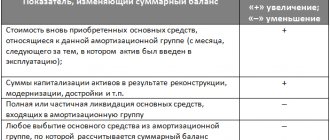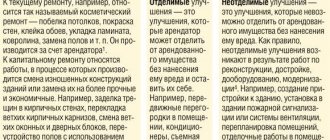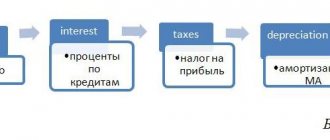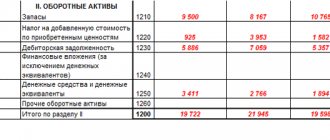Fixed assets used in the company wear out over time, and their value decreases. Therefore, persons carrying out activities and owning assets in the register of fixed assets make so-called depreciation charges. Thanks to them, the initial cost of this fixed asset is gradually recognized as part of tax expenses.
Depreciation (A) is a term that defines the decrease in the value of a thing at a given moment as a result of its use. A is applied to fixed assets and determines the real value of the object.
In certain situations, an entrepreneur can accelerate period A of fixed assets by increasing the standard depreciation rate. Accelerated linear A can only be applied to items of property used in hazardous conditions or subject to rapid technological advances. This will be discussed in this article.
Essence and concept
Accelerated depreciation is based on the principles of straight-line A. This means that all write-offs are equal, but their value is higher than in the case of straight-line depreciation. Fixed assets are calculated in a shorter period of time.
The essence of accelerated depreciation is as follows: entrepreneurs can shorten period A by applying increased rates. Of course, this is only possible after certain requirements are met, such as the use of fixed assets in conditions that indicate rapid consumption or in which rapid technological progress is observed.
It is preferable to use increased depreciation rates for buildings, vehicles and equipment subject to increased wear and tear. The legislation contains detailed instructions regarding the possibility of applying higher standards A.
Accelerated depreciation increases the amount of write-offs from fixed assets, while reducing the term A and the amount of taxes.
Depreciation in tax accounting
→ → Current as of: June 21, 2020 When calculating income tax, the accountant reduces the income received, among other things, by the amount of accrued depreciation on fixed assets and intangible assets.
Let's consider the main issues of calculating depreciation in tax accounting, including the use of special depreciation rates. To calculate the amount of depreciation for income tax, the accountant for each item of fixed assets and intangible assets must determine:
- depreciationgroup();
- depreciation method ().
Determining the depreciation group of fixed assets or intangible assets is important for the further use of the non-linear depreciation method and the application of the depreciation bonus. The depreciation group (from 1st to 10th) depends on the useful life of the property.
And the procedure for determining the SPI of property depends on the type of property: Type of property The procedure for determining the SPI Fixed assets Applies Classification of fixed assets included in depreciation groups ().
If the object is not specified in the Classification, then the SPI is determined in accordance with the technical specifications or recommendations of manufacturers. Intangible assets The validity period of the patent, certificate or other restrictions is applied as the SPI. For individual assets, SPI is determined by the organization independently, but for at least 2 years ().
If it is impossible to determine the SPI, it is considered equal to 10 years. The Organization independently establishes
What is it used for?
It is important to note that accelerated depreciation can be applied to all types of fixed assets. The entrepreneur has the right to increase the rates arising from the list of norms A, using the appropriate coefficients for:
- buildings and structures used in deteriorated or poor conditions;
- machines, devices and vehicles (except for the marine fleet) used more intensively than in average conditions or requiring special technical efficiency;
- machines and equipment that are subject to rapid technological progress.
All the main conditions for the use of this method are listed in Art. 259.3 Tax Code of the Russian Federation.
The essence of the accrual method in accounting and tax accounting
The essence of the accelerated depreciation method is to apply the coefficient of increased wear and tear of products and transfer the increased cost to the price of the final product.
In accounting, this increased coefficient cannot be more than 3, and for small enterprises - more than 2.
In tax accounting, it can take the value 2 or 3 depending on the basis - Article 259.3 of the Tax Code of the Russian Federation indicates cases of application of this parameter by organizations.
The factor is added to the basic depreciation rate, increasing it.
Conditions of use
Accelerated depreciation is the transfer of asset cost to product cost at an accelerated rate.
Since such deductions are accepted as expenses for income tax, tax regulations strictly regulate the issue of accelerated write-off.
When depreciating an asset using the accelerated method, it is allowed to apply one increase in depreciation from among the possible ones. The ban on the introduction of several coefficients was previously contained only in letters from the Ministry of Finance, but as of January 1. In 2014, it was enshrined in clause 259.3 of the Tax Code of the Russian Federation.
The taxpayer must indicate in the accounting policy what acceptable indicator will be used to calculate A at the rate.
The main prerequisites for using this type of accelerated depreciation:
- there is an urgent need to quickly write off an object;
- with increased equipment load at the very beginning of activity;
- if such objects include: electronic equipment, quickly becoming obsolete models;
- when regulating the load on a non-current asset;
- problems with writing off funds.
Increasing factor
Recipients of leasing on the basis of paragraph 3 of clause 9 of Order of the Ministry of Finance No. 15 have a privilege. Its essence is the possibility of using an accelerated coefficient. Its maximum possible value is 3. The coefficient is applied specifically to leased objects and specifically to depreciation. It can be used in both accounting and tax accounting. However, the coefficient becomes relevant only if these conditions are met:
- The leased object is on the balance sheet of the lease recipient.
- The declining balance method is used as a depreciation method (Resolution No. 2346/11 of July 5, 2011).
- When establishing the useful life, the item was not included in depreciation groups 1-3 (clause 2 of Article 259.3 of the Tax Code of the Russian Federation).
If these conditions are not met, then the coefficient cannot be used.
IMPORTANT! There is paragraph 5 of Article 259.3 of the Tax Code of the Russian Federation. It prohibits the simultaneous use of several coefficients for one subject. If a non-linear method is used when calculating depreciation, objects are accounted for by creating separate groups and subgroups for depreciation. This applies only to those objects in relation to which an accelerating factor is used. The basis is paragraph 13 of Article 258 of the Tax Code of the Russian Federation.
The legislation of the Russian Federation provides a special privilege for lessee companies (paragraph 3 of clause 9 of Order No. 15), which consists in the possibility of applying an accelerated coefficient (maximum equal to 3) for depreciation in leasing. The norm is valid both in accounting and tax, subject to the following conditions:
- The leased item must be listed on the balance sheet of the lessee company.
- The depreciation method in accounting is the reducing balance method (Resolution No. 2346/11 of 07/05/11).
- When determining SPI, the object is not included in depreciation groups 1-3 (subclause 1, clause 2, article 259.3 of the Tax Code).
Note! According to paragraph 5 of Art. 259.3 it is not allowed to use more than one increasing factor for a leased object. When depreciation is calculated in a non-linear way, accounting for objects for which an increasing factor is applied is carried out with the formation of separate depreciation groups/subgroups (clause 13 of Article 258 of the Tax Code).
Example
In accordance with Chapter 25 of the Tax Code of the Russian Federation, when calculating accelerated depreciation, a company can apply increasing factors to the depreciation rate.
The size of the maximum increasing factor depends on:
- on the method of acquiring property;
- from the depreciation group to which this or that object belongs.
Depreciation groups are established by law and are presented in Article 258 of the Tax Code of the Russian Federation. The main criterion for distributing property into depreciation groups is its useful life.
In accordance with Article 259.3 of the Tax Code of the Russian Federation, increasing factors of no more than 3 can be applied to cars and other types of vehicles or special equipment.
When determining the increasing coefficient, it should also be taken into account that when the leased asset is reflected on the lessee’s balance sheet, the size of the applied coefficient will be equal to the tax rate established for a vehicle with certain parameters.
The article describes taxi leasing for individual entrepreneurs:
taxi for lease
.
What is the difference between leasing and financial lease, read here.
Situations for using the method
List of situations allowing the use of accelerated depreciation rates:
- Aggressive environment conditions. The introduction of the coefficient is assigned to OSs that are operated in conditions of high environmental aggressiveness. The increase in coefficient A is no more than 2.
- Conducting agricultural production work provides for accelerated depreciation of all fixed assets. The increase in the coefficient is no more than 2.
- The company's work in an industrial-production or tourist-recreational zone gives the right to use a coefficient within 2 for all fixed assets used in the work.
- For objects on the balance sheet of the lessor (lessee) OS - coefficient 3.
- Application for offshore hydrocarbon production. The right to this depreciation within a coefficient of no more than 3 is provided for companies that have a license for this activity and offshore oil production operators. This exception applies to equipment that is used to develop a new mine.
- From 01/01/2008, depreciation of 3 times is applied to water supply and sewerage assets in the list that was approved by the Cabinet of Ministers of Russia.
The Tax Code does not prohibit the introduction of several coefficients for different groups of fixed assets. Aspects of the introduction of ratios must be specified in the company's accounting policies.
Accelerated depreciation in tax accounting
It is no secret that tax accounting provides various preferences for taxpayers. One of them is the use of an accelerated depreciation rate.
What specific coefficients can a food industry enterprise use? What differences arise with accounting and what deferred taxes on them need to be reflected in accordance with PBU 18/02 “Accounting for income tax calculations”? Answers to questions are given taking into account the explanations of officials and arbitration practice.
The application of increasing (decreasing) coefficients to the depreciation rate is provided for in Art. 259.1 of the Tax Code of the Russian Federation - namely, coefficients 2 and 3. Taxpayers have the right to apply the first of them in relation to: - depreciable fixed assets used to work in an aggressive environment and (or) extended shifts; – own depreciable fixed assets of industrial-type agricultural organizations (poultry farms, livestock farms, fur-bearing state farms, greenhouse plants); – depreciable fixed assets owned by organizations that have the status of resident of an industrial-production special economic zone or a tourist-recreational special economic zone; – depreciable property related to objects with high energy efficiency, in accordance with the list of such objects established by the Government of the Russian Federation; – objects of depreciable property that have a high energy efficiency class, if in relation to them the legislation provides for the determination of their energy efficiency classes.
Boosting
Calculation formula
In accounting, this method is also called the reducing balance method, where the application is based on the residual value of the asset, the acceleration factor and the useful life itself.
The accelerated depreciation formula looks like this:
A = St / SPI * K,
where A is the amount of depreciation charges, t. rub.;
St – residual value of the asset at the beginning of the year, t. rub.;
SPI – time of use of the asset, years;
K – acceleration coefficient. The maximum value is 3. For small enterprises - no higher than 2.
Features of calculating accelerated depreciation
Accelerated depreciation (Am) is calculated as follows:
Abbreviations: OSOS - residual value of the asset. Using this formula, Am is calculated for a year or a month. For calculation, data is taken for a year or, accordingly, for a month.
Calculation of the amount of accelerated depreciation (example)
Promversiya LLC entered into a leasing agreement for 3 years. Under it, it received equipment with an initial cost of RUR 1,200,000. rub., the service life of which is 6 years. The parties to the agreement reached an agreement on the use of accelerated depreciation with K = 2. The best option in the proposed situation is to write off the operating system during the validity of the contract, i.e. 3 years (SPI = 36 months). Based on these data, we calculate Am per year and per month.
| Data for calculation | Calculation Am per year | Calculation Am per month |
| OSOS = RUR 1,200,000 rub.; SPI=contract term=3 years; K=2 g. | Am (annual) = 1,200,000 / 3 * 2 = 800,000 RUR. rub. | Am (monthly) = 1,200,000 / 36 * 2 = 66,666 RUR. rub. |
Odds
The acceleration rate is a statutory fixed rate used to calculate the accelerated depreciation of fixed assets when a company has a basis.
This indicator varied from 2 to 3.
Using this indicator, the manufacturer includes the cost of depreciation of the operating system in the final price of the product, taking into account the multiplication by this indicator.
At the end, these amounts are reflected in the final cost of production in the direction of growth, which helps to compensate for equipment costs and reduce the amount of tax payments.
Factors that increase the value of depreciation write-offs used on this basis can be a maximum of:
- 1.2 in the case of buildings and structures used in deteriorated conditions;
- 1.4 in the case of buildings and structures used in poor conditions and the above-mentioned devices and vehicles;
- 2.0 for machines and equipment of groups 4-6.
What is important is that the coefficient applied by the entrepreneur should not reach the maximum amount specified in the regulations. However, it is worth remembering that choosing the highest possible ratio leads to the maximum reduction in the depreciation period.
Depreciation of leased property from the lessee
> > > September 26, 2020 Depreciation of leased property on the balance sheet of the lessee in accounting (BU) and tax accounting (TA) is different. Below we will talk about the rules for accounting for leased assets from the lessee and explain how to quickly write off the cost of the leased asset as expenses.
Leasing is a transaction involving 3 parties: the lessee instructs the lessor to purchase certain property for him from the seller. In turn, the lessor provides the acquired asset to the lessee for a fee for a specific period.
We recommend reading: Who will receive a pension increase from April 1, 2020
At the end of this period, the property is either returned to the lessor or purchased by the lessee. This point is separately stipulated in the leasing agreement. Regulatory framework for regulating leasing transactions:
- Law of October 29, 1998 No. 164-FZ “On Leasing” - to the extent that does not contradict later regulations on accounting;
- Art. 665–670 Civil Code of the Russian Federation;
- Instructions for reflecting operations under a leasing agreement in accounting records (hereinafter referred to as the Instructions), approved by Order of the Ministry of Finance of the Russian Federation dated February 17, 1997 No. 15.
If a leasing asset is accounted for under the agreement on the lessor’s balance sheet, then the lessee does not charge depreciation on such an asset.
If an asset under a leasing agreement is accounted for on the balance sheet of the lessee, then the latter charges depreciation from the month following the month of commissioning (clause
21 PBU 6/01, approved by order of the Ministry of Finance dated March 30, 2001 No. 26n, paragraphs. 50, 61 Methods of accounting for fixed assets, approved by order of the Ministry of Finance of the Russian Federation dated October 13, 2003 No. 91n).
Methods
Accelerated depreciation methods include the following:
- reducing balance;
- write-off of value based on the number of years of useful life;
- use of increasing coefficients.
The last method is the most common.
When applying the first method, the value of the property is measured, provided that the corresponding objects may be characterized by uneven returns throughout the entire period of application. It is relevant for products that quickly become obsolete.
The second method allows you to write off most of the cost of the operating system in the first years of operation of the object completely.
"Pitfalls" of accelerated depreciation
So, accelerated depreciation when leasing in 2020 allows you to significantly save on tax payments. However, its use is not without drawbacks.
- Deterioration of financial results. If we are talking about the purchase of an expensive object, the use of an accelerating factor may lead to losses for the organization in the first years after concluding a leasing transaction. The presence of losses may raise questions from regulatory authorities, as well as difficulties when working with banks, potential investors, etc.
- Complicating accounting. From an accounting point of view, the only acceptable accelerated method of calculating depreciation of fixed assets is the reducing balance method. It has no analogues in tax accounting. Therefore, the accelerated depreciation method assumes in any case that tax differences will arise between the two types of accounting. This can be seen, in particular, from the example above. In addition, the reducing balance method itself is more complex compared to the traditionally used linear method.
Application of accelerated depreciation during leasing
Organizations that have a leased asset on their own balance sheet can accrue A at an accelerated rate with a coefficient of no more than 3. The exception is objects of the 1st, 2nd and 3rd groups.
If the object is the entire enterprise, as a single material complex, accelerated depreciation under the leasing agreement is charged on all fixed assets, not counting assets belonging to the 1st, 2nd and 3rd groups.
Civil servants of the Ministry of Finance of the Russian Federation indicate that the lessor has the right to continue accrual at an accelerated pace, even if the tenant has changed.
A new tenant can use incremental values up to 3 when receiving a leased item that was previously owned by another user. The new owner can independently set the size of the coefficient, without relying on past data.
If the leased asset is used under an agreement concluded before January 1, 2002, it is accrued accelerated depreciation in accordance with the following rules:
- fees correspond to the method used to transfer property;
- accrual occurs using a coefficient of no more than 3;
- property depreciated in a non-linear manner should be separated into a separate subgroup.
Under what conditions is it permissible to use accelerated depreciation (list of situations)
Important! Accelerated depreciation is applied only to a limited range of assets that are characterized by rapid wear and tear. Their list is determined by Art. 259.3 Tax Code of the Russian Federation .
For all operating systems from the list, the so-called acceleration coefficient is applied (K = up to 2 or K = up to 3). Details of the OS list are given below along with the odds sizes.
Increasing coefficients for fixed assets used in aggressive environments
An aggressive environment is understood as an environment that can negatively affect surrounding materials and structures and cause their destruction. Under its influence, the wear and tear of the OS accelerates. A striking example is the interaction of an OS with a toxic substance.
Under these circumstances, it is permissible to use K = no more than 2. This norm does not apply when using a non-linear technique in relation to objects 1, 2 and 3 of depreciation. gr.
In fact, acceleration can also be used when depreciating objects that, according to their intended purpose, should not be used in an aggressive environment. If the documentation contains a note about the possibility of such use, then it is usually used when there is an excess of the standards stated in the documents.
Important! The use of an increased coefficient applies only to those objects that are exposed to an aggressive environment. The remaining fixed assets are subject to depreciation in the usual manner, without acceleration.
Depreciation of fixed assets used in scientific and technical activities
All objects participating in this activity are subject to accelerated depreciation with the participation of K = up to 3. The concept of “scientific and technical activity” (hereinafter abbreviated as NTD) is explained by Art. 2 Federal Law of the Russian Federation No. 127 dated August 23, 1996. Nevertheless, the Ministry of Finance of the Russian Federation, referring to the norms of Art. 262 of the Tax Code of the Russian Federation, also includes research and design developments.
Accelerated depreciation of leased objects (+example)
In the case of leasing, the established coefficient cannot exceed 3. For example, Tekhnika LLC, under a leasing agreement, received equipment classified as 4 depreciation. gr. The validity period of the contract is 3 years. The balance holder (tenant) determined the SPI = 6 years. By agreement of the parties, a coefficient of 2 was established. It is assumed that the equipment will be written off within 3 years of leasing.
Features of accelerated depreciation during leasing:
- When the lessee changes, the lessor continues to charge depreciation.
- If the entire enterprise is comprehensively recognized as a leasing object, then depreciation is charged on all fixed assets. The exceptions are those OS that relate to 1, 2 or 3 depreciations. group.
For your information, the new lessee has the right to change the amount of increase for the property that was transferred to him from the previous lessee.
Example
The transport company purchased an SUV that will transport expedition participants along with all the necessary equipment. Due to the purpose of this vehicle and the difficult operating conditions in which it will be used, it was decided to increase the depreciation rate using the maximum coefficient: 1.4. The initial cost of the car was 700 thousand rubles.
Calculation of monthly depreciation: 700 thousand rubles. X 20% x 1.4: 12 months = 16.33 thousand rubles.
In the case of traditional depreciation, the monthly write-off will be: 700 thousand rubles. X 20%: 12 months = 11.66 thousand rubles.
Accelerated depreciation in tax accounting
Free consultation by phone Contents The quality of management of the company’s financial and economic activities depends on effectively organized management and the degree of information support for its services. Today, a small number of domestic enterprises are distinguished by their established accounting system and organized management, ensuring the suitability of information for analysis and operational management.
At the same time, it must be accurate and objective. Information from accounting services must have a small number of indicators that will satisfy the maximum number of users.
Accounting data must be generated in order to make the right decisions aimed at effectively managing the processes of the enterprise. The management of each enterprise cares about the efficiency of using property for the rational development of the business, since fixed assets have a considerable value. To update its active part, you can use special methods, for example, the accelerated depreciation method. Depreciation of fixed capital as a category of the economy is part of the costs that will be included in production costs. In addition, it is an accumulated financial source of income used to restore capital investments. Fixed assets have been involved in various types of activities of the organization for a long time.
However, they gradually wear out and divide their own value between the costs of circulation and production.
How to apply an increasing depreciation rate for leased property: accounting
December 7, 2010 December 7, 2010 In the previous article from the series on the rules for accelerated depreciation of fixed assets, consultant Ilya Antonenko, who is known to participants of the Online Accounting forum as, spoke about the features.
The article published today is devoted to one of the most controversial topics in accounting - accelerated depreciation of leased property. Suffice it to say that, according to the Ministry of Finance, accelerated depreciation of the leased asset actually does not exist in accounting.
In accordance with Article 31 of Federal Law No. 164-FZ dated October 29, 1998 “On financial lease (leasing),” depreciation deductions are made by the party to the leasing agreement on whose balance sheet the leased asset is located (hereinafter referred to as the balance holder of the leased asset).
It is established that the parties to the leasing agreement have the right, by mutual agreement, to apply accelerated depreciation of the leased asset. It would seem that this norm allows the holder of the balance sheet of the leased asset to apply accelerated depreciation in accounting by analogy with tax accounting.
That is, use any method of depreciation and an increasing factor not higher than 3.
The same conclusion follows from the provisions of the Directive on the reflection in accounting of transactions under a leasing agreement (approved.
by order of the Ministry of Finance of Russia dated February 17, 1997 No. 15). Thus, in paragraph 9 of the Instructions, dedicated to the accounting of leasing operations with the lessee, the following is stated: “accrual
We draw up an order not to accrue depreciation
For individual fixed assets, depreciation in accounting is not accrued from the moment such objects are registered. And for other objects, depreciation may be terminated under certain conditions. Thus, fixed assets whose consumer properties do not change over time (for example, land plots and environmental management facilities) are not depreciated (clause 17 of PBU 6/01). Depreciation stops accruing on fixed assets transferred to conservation for a period of more than 3 months, as well as during the period of restoration (repair, modernization and reconstruction) of fixed assets, if its duration exceeds 12 months (clause 23 of PBU 6/01).
Since non-accrual of depreciation of fixed assets or their exclusion from depreciable property requires a basis, the drawn up order will be such a justification for excluding property from depreciable property. The order is drawn up in any form. It indicates a list of property, as well as the reason why depreciation on objects is not accrued.
When depreciation on fixed assets is not accrued in principle (for example, on land), the order may not be drawn up. But when excluding an object from depreciable property (for example, when transferring it to conservation), you cannot do without an order.
As a rule, during restoration or conservation, the provision on non-accrual of depreciation is one of the points of the organizational and administrative document establishing the need for restoration or conservation in relation to specific objects. That is, a separate order dedicated exclusively to non-accrual of fixed assets is usually not drawn up.
We provide a completed sample of an order not to accrue depreciation on fixed assets in connection with their transfer to conservation.
Prev. / Next You can download the form for an order not to accrue depreciation of fixed assets (sample form) in connection with conservation here. Only subscribers of the Main Ledger magazine can download document forms.
- I am a subscriber: electronic magazine printed magazine
- I'm not a subscriber, but I want to become one
- I want to download document forms for free and try all the features of a subscriber
The given form of an order not to accrue depreciation of fixed assets can be used for the purposes of not only accounting, but also tax accounting, when depreciation of objects is not accrued or ceases to be accrued in accordance with the requirements of Chapter. 25 Tax Code of the Russian Federation.
It is impossible to imagine the production process without fixed assets (Fixed Assets). Ensuring the creation of a product, they wear out, that is, they are depreciated, contributing part of their price to the cost of the released product. These amounts, accrued monthly in equal installments, are combined under the term “depreciation”, and the rate of deductions established by the state is defined as the “depreciation rate”.
The depreciation rate is a value calculated as a percentage of the price of the fixed asset used in the enterprise. The cost of any product produced by a company always includes a share of depreciation of fixed assets. We will learn how to determine the depreciation rate and make the necessary calculations from this article.
The procedure for calculating depreciation of fixed assets in accounting
Depreciation involves the gradual inclusion in expenses of the cost of fixed assets, which is a significant amount for any organization. Fixed assets can participate in generating income for a long time and have a long service life.
Depreciation of fixed assets must be calculated for all groups. But some of the property does not need to be depreciated:
- if the initial cost is within the limits of the maximum value not exceeding 40,000 rubles. (clause 5 of PBU 6/01) (if these objects are accepted for accounting as inventories);
- if the object is on the list of property for which depreciation is not accrued (clause 17 of PBU 6/01).
Read about non-depreciable fixed assets in the material “Rules for calculating depreciation of non-current assets”.
PBU 6/01 is the main document that establishes the rules for calculating depreciation of fixed assets in accounting. When accepting for accounting for each individual object, the organization determines the depreciation procedure based on PBU 6/01 and fixes the parameters: the method of calculating depreciation of fixed assets and their useful life.
Read about the basic rules for calculating depreciation of fixed assets in the already familiar material “Rules for calculating depreciation of non-current assets.”
Results
When deciding how depreciation of fixed assets will be calculated in 2018-2019, the organization has the right to choose: reducing the labor intensity of accounting or the absence of differences according to PBU 18/02. At the same time, it is reasonable to make a decision also from the point of view of reducing tax expenses. This, in particular, is facilitated by the use of the right to immediately attribute the cost of objects to expenses.
You can find more complete information on the topic in ConsultantPlus. Full and free access to the system for 2 days.
How to calculate the depreciation rate
So, the percentage required to reimburse the price of the operating system is calculated using the formula:
% = 1 / SPI
Example
Calculation of depreciation rates.
A hardware processing company operates a turning and milling machine worth RUB 300,000. The SPI of the object is 20 years. Based on this information, you can calculate the amount of depreciation for the year:
300,000 rub. / 20 years = 15,000 rub.
The depreciation rate as a percentage will be equal to:
15,000 rub. / 300,000 rub. × 100% = 5%.
The depreciation rate is established depending on the depreciation calculation methodology adopted by the company. There are four possible accounting methods:
- linear, when deductions are made in equal shares over the full life of the object (as in the presented example);
- the declining balance method, in which deductions are calculated by the ratio of the depreciation rate to its residual (rather than original) value for each reporting year. Continuing the example, let's calculate the amount of depreciation for the next year. If in the 1st year of operation 5% of 300,000 rubles amounted to 15,000 rubles, then in the 2nd calculation it will be as follows: 5% of 285,000 rubles. (300,000 – 15,000), i.e. 14,250 rubles. In this case, the depreciation rate has not changed, but the amount of depreciation has decreased. When using accelerated depreciation, its rate for the year can be calculated using the formula % = K / SPI, where K is the increasing coefficient adopted in the company. It cannot be higher than 3;
- method of writing off the cost according to the aggregate SPI. When using this method, the calculation does not involve calculating the depreciation rate. However, understanding by it the share of the cost of the fixed assets object, recognized as the annual depreciation rate, the calculation formula may look like this: N = ChL / ∑CHL, where CHL is the number of years remaining until the end of the fixed investment period of the fixed assets object, and ∑CHL is the sum of the number of years of the fixed assets period. In our example, the calculation will be as follows: - in the 1st year % = 20 years / (1 + 2 + 3 + 4 + 5 + 6 + 7 + 8 + 9 + 10 + 11 + 12 + 13 + 14 + 15 + 16 + 17 + 18 + 19 + 20) = 9.5%.
- Depreciation rate (NA) = 9.5% x RUB 300,000. = 28,500 rub.;
- — in the 2nd year % = 19 years / 210 = 9%
- NA = 9% x 30,000 = 27,000 rub. etc.;
- When applying this method, the depreciation rate will decrease, as will the amount of wear and tear.
When calculating depreciation rates for tax purposes, only two methods will be used - linear and nonlinear. Linear is the most popular and is used in 70% of existing companies. It is considered simple, concise and precise.
Example of calculating depreciation of fixed assets
Let's look at an example of how to calculate depreciation of fixed assets in practice.
Example
In January 2020, the organization accepted into operation an object with an initial cost of 72,000 rubles. The fixed useful life is 3 years (36 months).
The linear depreciation method chosen by the organization provides for the following calculation of the annual depreciation amount: 72,000 × 1 / 3 = 24,000. Here 1/3 is the depreciation rate. It is calculated based on the specified number of years of operation. In fact, the annual amount can be obtained by simply dividing the cost by the number of years; in practice, this is how the calculation is made.
The monthly depreciation amount is equal to the result of dividing the annual amount by the number of months in the year: 24,000 / 12 = 2,000. Or, which is equivalent, the result of dividing the original cost by the number of months of use: 72,000 / 36.
Is it possible to apply multiple coefficients?
In practice, it happens that the same fixed asset item meets several criteria that entitle it to an increasing coefficient. For example, if the equipment is used to work in an aggressive environment and (or) extended shifts and at the same time belongs to objects with high energy efficiency. Or the OS object is used for work in conditions of an aggressive environment and (or) increased shifts and at the same time is the subject of a leasing agreement. Is it legal for the purposes of calculating income tax to simultaneously apply several increasing factors to the basic depreciation rate in these situations? Officials give a negative answer (Letter of the Ministry of Finance of the Russian Federation dated September 14, 2012 No. 03-03-06/1/481). The possibility of simultaneous application of several increasing factors to the depreciation rate of an object of depreciable property Ch. 25 of the Tax Code of the Russian Federation is not provided for. Therefore, if there are grounds for applying several coefficients to the depreciation rate of fixed assets, according to officials, the taxpayer should determine in the accounting policy which of these coefficients will be applied for profit tax purposes.
New cost limits for calculating asset depreciation
According to paragraph 39 of the Federal Accounting Standard for Public Sector Organizations “Fixed Assets”, approved. by order of the Ministry of Finance of Russia dated December 31, 2016 No. 257n:
Excerpt from the document
“Depreciation of an object of fixed assets is calculated taking into account the following provisions: a) for an object of fixed assets worth over 100,000 rubles, depreciation is calculated in accordance with the calculated depreciation rates; b) for fixed assets worth up to 10,000 rubles inclusive, with the exception of library collection objects, depreciation is not charged. The initial cost of a fixed asset object commissioned (transferred) into operation, which is an object of movable property, worth up to 10,000 rubles inclusive, with the exception of library collection objects, is written off from the balance sheet while simultaneously reflecting the fixed asset object on an off-balance sheet account in accordance with the procedure for applying the Unified Plan accounting accounts; c) for a library fund object worth up to 100,000 rubles inclusive, depreciation is charged in the amount of 100% of the original cost when it is put into operation; d) for another fixed asset costing from 10,000 to 100,000 rubles inclusive, depreciation is charged at 100% of the original cost when it is put into operation.”
Previously, in accordance with paragraph 92 of the Instructions for the Application of the Unified Chart of Accounts, approved. By order of the Ministry of Finance of Russia dated December 1, 2010 No. 157n (as amended on September 27, 2017) (hereinafter referred to as Instructions No. 157n), depreciation for fixed assets was accrued in the following order:
Excerpt from the document
“for an object of real estate when accepting it for accounting upon the fact of state registration of rights to objects of real estate, provided for by the legislation of the Russian Federation: worth up to 40,000 rubles inclusive - depreciation is charged in the amount of 100% of the book value of the object upon acceptance for accounting; costing more than 40,000 rubles - depreciation is calculated in accordance with depreciation rates calculated in accordance with the established procedure;
for movable property objects: for objects of the library collection worth up to 40,000 rubles inclusive, depreciation is accrued in the amount of 100% of the book value when the object is put into operation; for fixed assets worth more than 40,000 rubles, depreciation is accrued in accordance with depreciation rates calculated in accordance with the established procedure; for fixed assets worth up to 3,000 rubles inclusive, with the exception of library collections and intangible assets, depreciation is not accrued; for other fixed assets worth from 3,000 to 40,000 rubles inclusive, depreciation is accrued in the amount of 100% of the book value when the object is put into operation.”
Thus, from January 1, 2018, the limits on the value of fixed assets for calculating depreciation have been increased.
In the program “1C: Public Institution Accounting 8”, editions 1 and 2, in accordance with the requirements of paragraph 39 of the Standard in the register of information, Asset Accounting Parameters, from 01/01/2018, new cost limits have been established for calculating depreciation of fixed assets:
- the first limit is RUB 10,000.00;
- the second limit is RUB 100,000.00.
They are used in OS commissioning documents. In the Guidelines for the application of the federal accounting standard for public sector organizations “Fixed assets”, approved. Order of the Ministry of Finance of Russia dated December 31, 2016 No. 257n (hereinafter referred to as the Methodological Instructions), communicated by letter of the Ministry of Finance of Russia dated December 15, 2017 No. 02-07-07/84237, explained how to calculate depreciation on fixed assets accepted for accounting in 2017, which will be put into operation in 2020.
According to Part 7 “Depreciation of fixed assets” of the Methodological Instructions: “in relation to fixed assets items accepted for accounting before the transition to the use of the GHS “Fixed Assets” (before January 1, 2018), recalculation of depreciation (change in the method of calculating depreciation determined at the time of recognition object for accounting) is not carried out." Thus, for fixed assets costing from 3,000 rubles. up to 10,000 rub. inclusive, accepted for accounting in 2020, but not put into operation, the method of calculating depreciation established on the date the object was accepted for accounting does not change, the old one remains. For OS objects, costing:
- up to 3,000 rub. inclusive, with the exception of library collection objects and intangible assets, depreciation is not accrued;
- from 3,000 to 40,000 rubles. inclusive, depreciation is accrued in the amount of 100% of the book value when the facility is put into operation.
Therefore, the commissioning of these operating systems in 2020 should be reflected in accounting in the old way:
- on the debit of the corresponding analytical accounting accounts of account 010100000 “Fixed Assets” and the credit of the corresponding analytical accounting accounts of account 010100000 “Fixed Assets” with a change in the financially responsible person (clause 10 of the Instructions for the application of the Chart of Accounts for accounting of budgetary institutions, approved by order of the Ministry of Finance of Russia dated 16.12 .2010 No. 174n, hereinafter referred to as Instruction No. 174n);
- by the debit of account 040120271, the corresponding analytical accounting accounts of account 010900000 “Costs for the manufacture of finished products, performance of work, services” and the credit of the corresponding analytical accounting accounts of account 010400000 “Depreciation” in the amount of book value (clause 26 of Instruction No. 174n).
Accordingly, when carrying out the documents Internal movement of fixed assets and intangible assets in the program “1C: Accounting of a state institution 8” with the operation Putting into operation OS (in “1C: Accounting of a state institution 8” edition 1) and the Statement for issuing OS for the needs of the institution (in “ 1C: Accounting Department of a State Institution 8" edition 2) with the operation Commissioning for objects put into operation in 2018 costing from 3,000 rubles. up to 10,000 rub. inclusive, accepted for accounting in 2020, accounting records are formed in the old way, according to the method of calculating depreciation determined at the time the object was accepted for accounting - depreciation is calculated in the amount of the book value.
Also, additional depreciation is not charged up to 100% of the book value of an object worth RUB 40,000 or more. up to 100,000 rubles, accepted for accounting in 2020, upon commissioning in 2018. Depreciation continues to accrue for the asset in accordance with the established useful life (SPI).
New limits on the value of fixed assets for calculating depreciation are applied to objects accepted for accounting from 01/01/2018.








